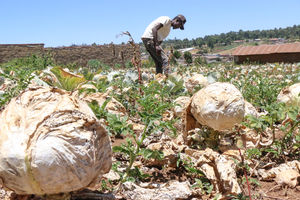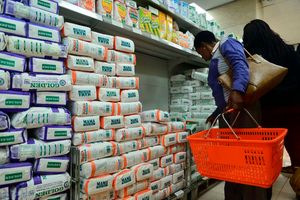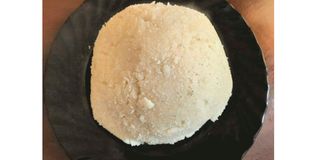
Kenyans will pay more for maize flour as several millers suspended operations due to an acute shortage of the grain.
Millers have warned a maize shortage in the North Rift will soon cause consumer prices of flour to skyrocket.
Some millers have been forced to suspend operations and reduce workforce citing maize unavailability.
It has emerged that most farmers sold their maize shortly after harvest to dealers exporting to neighboring countries, including Uganda and South Sudan, because of attractive prices.
A 90-kilogram bag of maize is selling at Sh4,200 in the local market compared to Sh4,600 in Uganda and Sh5,200 in South Sudan.
“We are staring at an impending disaster as maize supply deteriorates in the market after most farmers sold out the produce during harvest period. Some of the farmers exported the produce to Uganda and South Sudan due to high prices,” said Mr David Kosgei, an Eldoret miller and food expert.
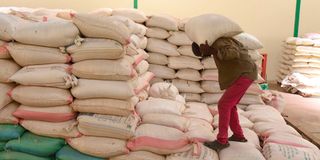
A worker offloads bags of maize at the Nakuru NCPB depot on January 31, 2024.
Most parts of Uganda experienced crop failure last season due to unrelenting dry spell and traders turned to Kenya to plug the maize shortage.
“Most farmers have exhausted their maize stock after they sold the produce during the harvest period driven by high demand of maize and attractive rates in parts of Uganda and South Sudan,” added Mr Jackson Kemboi, an agriculture expert and farmer in Uasin Gishu county.
Also Read: Pricing wars: Commercial seed maize growers now threaten to stop production over high costs
Traditionally, South Sudan relies on maize imports from Uganda, but with the shortage of the grain, Juba turned to imports from Kenya and the neighboring Southern African member States- Zambia, Zimbabwe and South Africa.
“The demand for maize is increasingly high and there are no imports from countries such as Tanzania, Zambia, Zimbabwe or South Africa. There will be a shortage that will push the prices beyond reach of most households,” said Mr Kipng’etich Mutahi, an Eldoret-based maize miller.
Imports to the rescue
Most millers are now relying on maize imports from Tanzania landing at Sh3,850 at Sirare border and above Sh4,300 in Nairobi and other markets in the country.
“Some of the millers have pitched camp here due to plenty of maize from Tanzania going at Sh3,850 per a 90-kilogram bag but the prices are subject to review due to the increasing demand,” said Mr Gideon Mosoba, a trader from Sirare market.
Several millers in the Western Kenya region have suspended operations due to maize shortage. At least 10 small and large-scale milling plants have sent some of their staff on leave after scaling down operations due to acute maize shortage.
“We have been crushing below capacity for the last two weeks, which has forced us to suspend operations until we obtain sufficient stocks,” said one of the millers.
“Consumers are already struggling with increasing unga price, which is above Sh150 up from Sh120 per two-kilogram packet,” said the miller, adding several millers had shut down as most maize is exported to Uganda and South Sudan, where it is fetching higher prices.
The Ministry of Agriculture has admitted an impending maize shortage due to the growing competition for limited stocks between animal feed manufacturers and millers for human consumption.
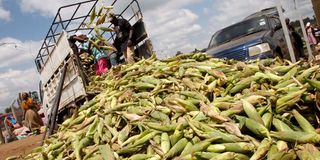
Maize farmers in the North Rift region have taken the government to task over the deteriorating buying prices for the crop.
This has led to a rise in prices by approximately 26 percent, which is hitting hard households reliant on the staple food.
The rising maize prices in regional and international markets amid scarcity as a result of disrupted global production due to erratic climate conditions, disease outbreaks, and the lengthy Ukraine war threatens to the government’s campaign to reduce price of unga.
According to the Kenya National Bureau of Statistics, Kenya has imported an average of 295,092 tonnes of maize annually over the past five years.
Maize production is estimated at 3.2 million metric tons annually against the consumption of 3.8 million metric tonnes with the deficit being bridged through imports from East Africa Community (EAC) Member states.
The Ministry of Agriculture is set to open imports of 5.5 million bags of yellow maize and release regular maize from the National Strategic Food Reserve (NSFR) to millers.
“The government will gazette a 50 percent duty waiver for the importation of 5.5 million bags of yellow maize over one year. This initiative will be carried out by a vetted list of qualified animal feed millers with sufficient capacity,” Agriculture CS Mutahi Kagwe has announced.

Agriculture Cabinet Secretary Mutahi Kagwe.
He decried the cutthroat competition between manufacturers of animal feeds and millers for the scarce maize saying it was hurting consumers who have to cope with the rising cost of maize flour.
“This upward trend in maize prices has directly impacted the cost of production, prompting millers to pass the increased costs onto consumers through higher prices of maize flour (unga). This intervention aims to cushion the mwananchi from the impact of soaring unga prices,” disclosed Mr Kagwe.
Agriculture experts and farmers have cast doubts on the accurate production volume of maize in the country last season terming the 75 million bags as impractical and warning of a further shortage that would push the cost of unga beyond the reach of most households.
“What is emerging is that the maize harvest last season was below the 75 million bags as projected by the government. This can be attributed to the supply of substandard fertilizer and fake seed, land fragmentation into uneconomical units, the repeated disease outbreak and heavy rains during harvest period contributed to the decline in yield,” said Mr Ezekiel Koech, an Eldoret-based agricultural expert.
The Ministry of Agriculture projected a maize yield of 75 million bags last season, attributing the bumper harvest to favorable weather conditions and the government’s fertilizer subsidy program.
The country produced 47.6 million bags of 90 Kg in the 2023 season -an increase of about 38.8 percent compared to the previous period.



